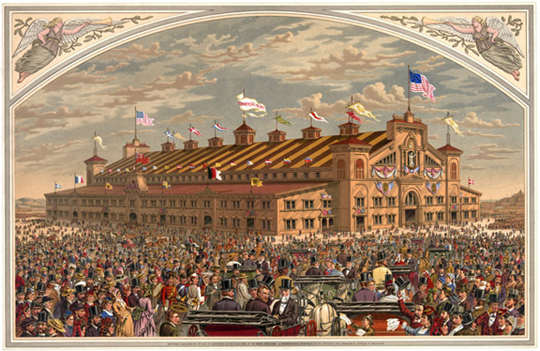On June 17, 1872, the 18-day World Peace Jubilee + International Music Festival opened in Boston's Back Bay
For 18 days in the summer of 1872, Boston hosted the largest concert in history.
A century and a half ago, from June 17 to July 4, 1872, some 20,000 singers and 2,000 musicians came to Boston from around the world to participate in the World Peace Jubilee and International Music Festival, the largest musical gathering ever undertaken in history.
The Jubilee ran from Bunker Hill Day to Independence Day, 1872, and was held in a giant coliseum erected in Boston’s Back Bay. The musicians and singers performed in various ensembles and also en masse, to convey the joy, solace and inspiration that music brings, and to express a profound relief, even if temporary, that there was peace in the world.
Patrick S. Gilmore
The man behind the festival was Patrick Sarsfield Gilmore, a gifted cornetist, bandleader and impresario who had devoted his life to the audacious dream that music had the power to change the world; that it could be used as an instrument of peace.
Born in Ballygar, Galway on December 25, 1829, Gilmore immigrated to Boston in 1849, where he became a successful bandleader through the 1850s.
During the Civil War, Gilmore and his band volunteered with the Massachusetts 24th Infantry, playing for the troops on both sides of the conflict. Gilmore had organized monster concerts to celebrate peace in the nation in New Orleans in 1865 and Boston’s National Peace Jubilee in 1869. But the 1872 World Peace Jubilee would be his largest endeavor.
President Ulysses S. Grant, who had been at the 1869 Jubilee, attended the concerts, and so did his presidential opponent Horace Greeley. Senators, congressmen, governors from as far away as Kansas descended upon Boston, along with ministers from Turkey, Ecuador and the Netherlands.
And finally, opening day arrived.
“The sun was bright and the sky was blue. The parks and cemeteries studding the place were robed in richest green, and the streets teemed with a population in holiday attire and brimming with holiday sentiments,” a newspaper reported about opening day.
In the end, it was the music that had people talking.
Gilmore’s practice as a bandleader was to mix classical and popular music at his concerts, to democratize the enjoyment of music for American audiences. So Bach, Mendelsohn, Mozart and Handel were featured, with sacred hymns like “Hallelujah” from The Messiah, “To God on High” and “Gloria.”
Irish songs like “The Last Rose of Summer” received hearty encores and so did Gilmore’s own song, “When Johnny Comes Marching Home.” “The Star Spangled Banner” was played daily along with popular hymns like “Rock of Ages” and the Festival’s unofficial anthem, “Angel of Peace,” with words by Dr. Oliver Wendell Holmes.
Decades later, people still talked about three high points of the World Peace Jubilee held in Boston:
Johann Strauss
• Johann Strauss, the Austrian waltz king, made his American debut at the Jubilee, having met Gilmore in Vienna the previous summer. Strauss conducted his famous waltz, “The Beautiful Blue Danube,” to thunderous applause, and composed a Jubilee Waltz for the occasion. So popular was Strauss that his wife reportedly sold locks of his hair as souvenirs to female fans.
Fisk Jubilee Singers
• The Fisk Jubilee Singers, a group of black college students from Fisk University in Nashville, performed at the Jubilee, “sending the audience into a rapture of boisterous enthusiasm” for its rendition of “Mine Eyes Have Seen the Glory of the Coming of the Lord.” An impressed President Grant invited them to perform at the White House later that year, helping to launch a singing ensemble that flourishes today.
Boston Firemen's Anvil Chorus at Boston Public Garden (from 1869 performance)
• The unlikely stars of the Jubilee were 100 men from the Boston Fire Department, resplendent in red shirts and white suspenders, who were enlisted to pound 100 anvils to accompany the singers of The Anvil Chorus from Verdi’s Il Trovatore. As the firemen clanged their hammers in unison, cannons outside the coliseum were firing and all of Boston’s church bells were ringing as the orchestra of 2,000 reached a crescendo unheard of in the world.
The World Peace Jubilee was significant for another reason: for one brief shining moment in human history, an army of musicians had prevailed.
Gilmore spent the final twenty years of his life touring with the Gilmore Band, throughout Europe and across the United States. He died in 1892 while on tour in St. Louis, and is buried at Calvary Cemetery in Queens, New York.
This article is a condensed version of a story originally published in Irish America Magazine.








Comments
Post a Comment